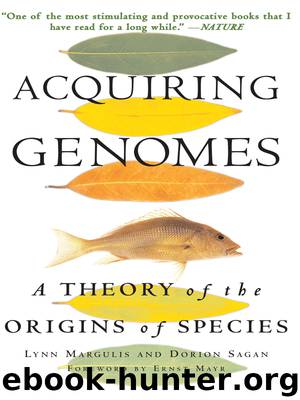Acquiring Genomes by Lynn Margulis

Author:Lynn Margulis [LYNN MARGULIS AND DORION SAGAN]
Language: eng
Format: epub
Publisher: Basic Books
Published: 2011-12-23T16:00:00+00:00
INDEPENDENT ORIGINS OF AGRICULTURE
Several times in Earth history, social animals have domesticated their food sources: Agriculture evolved in termites, ants, and people. “Domesticate” means “take into the house.” Some agricultural associations became even more intimate: Food sources are not only grown very close to home but on the body itself. Here we tell one story of the origin of backyard farming and then briefly describe the even closer relationship of “body farming.” The former association between termite and fungus sets the stage, while the latter, between bacteria and termite protist, demonstrates foreign genome acquisition. Food bacteria, food algae, and even food starchstoring ciliates are grown, respectively, inside the bodies of certain protists, green worms, and cows.
The lush tropical forest around the Tiputini Biodiversity Station in Ecuador can only be reached by a six-hour “canoa,” a ride in a motorized unprotected river boat down the river from Coca. Termites, including the frenetic subterranean species Heterotermes tenuis, abound in the region, especially in fallen wood. Like all members of the family Rhinotermitidae, these masters of cellulose digestion harbor a varied and active crew of microbes in their bloated hindguts. On puncturing the gut one could recognize wood in the process of degeneration. Wood pieces can be seen directly through the translucent bodies of moving hypermastigote cells such as Trichonympha and some of the pyrsonymphids.
A few hundred members of the colony of busily bustling termites were brought into the laboratory but kept in their own home—a decaying log. Two weeks later, all over the decomposing branch sprouted what looked like hundreds of distinct, long-lasting drops of water, half a millimeter in diameter, but they weren’t water. Microscopic observation showed the “water droplets” to be “sporodochia,” a term we had to look up in a mycological dictionary. The sporodochia were packets of tissue of an obscure “fungus imperfectus” limited to the southern hemisphere. With help from some friends we located the extremely obscure and small scientific literature about them. The sporodochia made us wonder about fungal farming, so well known in the non-wood-eating “higher termites.” Is “fungal farming” by wood-eating termites beginning anew in the tropics of South America? Are we witnessing an independent origin of agriculture?
Andrew Wier, a graduate student, electron microscopist, and scuba diver, returned from two weeks at the Tiputini Biodiversity Station in the winter of the first year of the new millennium. He came back to the Margulis laboratory full of the joys of the Ecuadorian rainforest. He seemed to recognize some of the great buttressed trees as Iriartea, members of the Aracaceae family. A profusion of pineapplelike bromeliads stick epiphytically on many of Iriartea’s branches and trunks. Certain bark-dwelling cyanobacteria turn trunks green, while white-paint-like fungi make them look like paper birds. The diversity of the luxuriant palms is marvelous. Wier was not too surprised to find that Tiputini was at too low an altitude to be home for Gunnera manicata, a huge symbiotic flowering plant that we will meet again in Chapter 11. He marveled at Bart Bouricious’s Amazon treetop walkway, forty meters above the forest floor.
Download
This site does not store any files on its server. We only index and link to content provided by other sites. Please contact the content providers to delete copyright contents if any and email us, we'll remove relevant links or contents immediately.
| Cell Biology | Developmental Biology |
| Entomology | Marine Biology |
| Microbiology | Molecular Biology |
| Biostatistics |
Sapiens: A Brief History of Humankind by Yuval Noah Harari(13035)
The Tidewater Tales by John Barth(12024)
Do No Harm Stories of Life, Death and Brain Surgery by Henry Marsh(6331)
Mastermind: How to Think Like Sherlock Holmes by Maria Konnikova(6217)
The Thirst by Nesbo Jo(5776)
Why We Sleep: Unlocking the Power of Sleep and Dreams by Matthew Walker(5633)
Sapiens by Yuval Noah Harari(4526)
Life 3.0: Being Human in the Age of Artificial Intelligence by Tegmark Max(4490)
The Longevity Diet by Valter Longo(4439)
The Rules Do Not Apply by Ariel Levy(3896)
The Immortal Life of Henrietta Lacks by Rebecca Skloot(3816)
The Body: A Guide for Occupants by Bill Bryson(3787)
Why We Sleep by Matthew Walker(3765)
Animal Frequency by Melissa Alvarez(3748)
Yoga Anatomy by Kaminoff Leslie(3696)
Barron's AP Biology by Goldberg M.S. Deborah T(3625)
The Hacking of the American Mind by Robert H. Lustig(3572)
All Creatures Great and Small by James Herriot(3506)
Yoga Anatomy by Leslie Kaminoff & Amy Matthews(3389)
